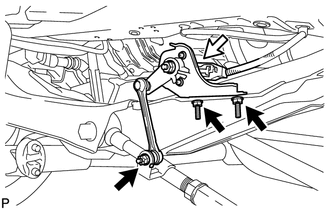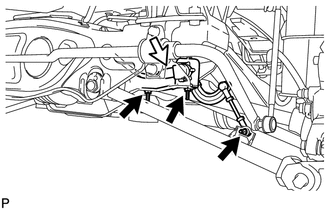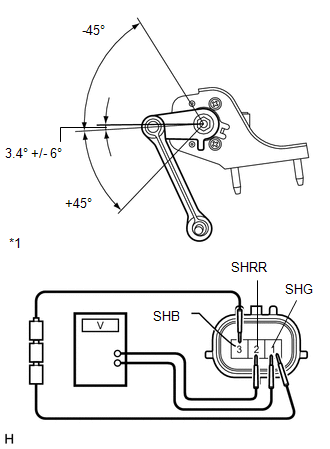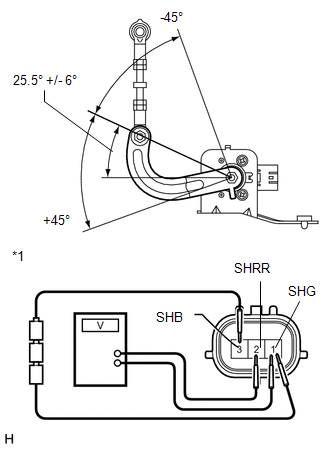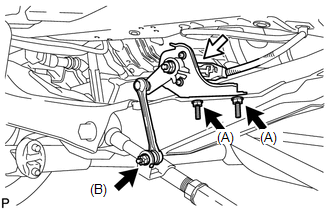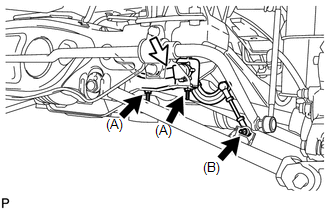Toyota Venza: Height Control Sensor
Components
COMPONENTS
ILLUSTRATION
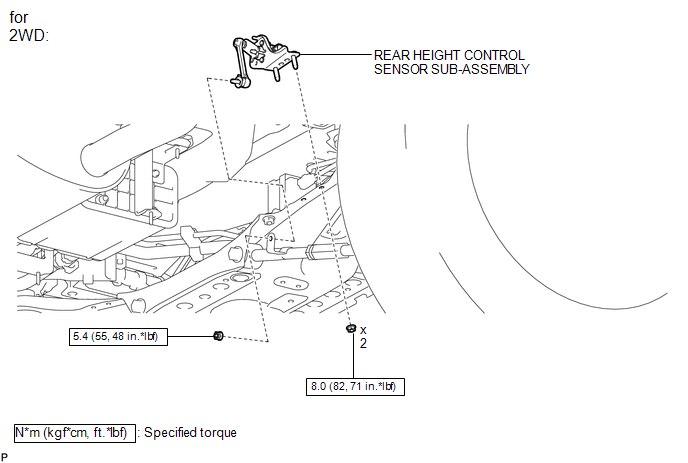
ILLUSTRATION
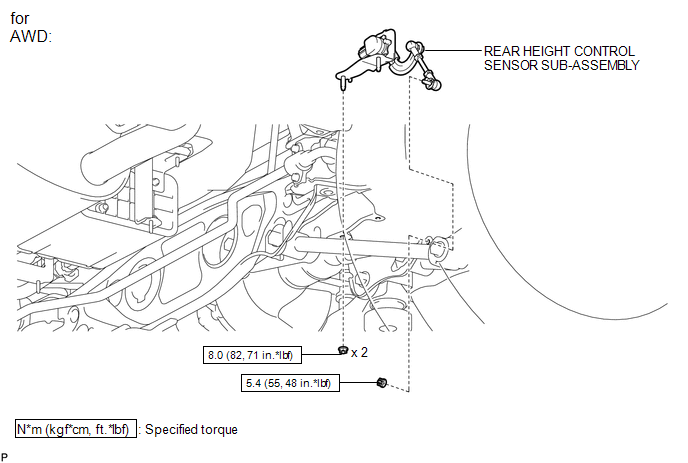
Removal
REMOVAL
PROCEDURE
1. REMOVE REAR HEIGHT CONTROL SENSOR SUB-ASSEMBLY (for 2WD)
|
(a) Disconnect the connector. |
|
(b) Remove the 3 nuts and rear height control sensor sub-assembly.
2. REMOVE REAR HEIGHT CONTROL SENSOR SUB-ASSEMBLY (for AWD)
|
(a) Disconnect the connector. |
|
(b) Remove the 3 nuts and rear height control sensor sub-assembly.
Inspection
INSPECTION
PROCEDURE
1. INSPECT REAR HEIGHT CONTROL SENSOR SUB-ASSEMBLY RH (for 2WD)
|
(a) Connect 3 dry cell batteries (1.5 V) in series. |
|
(b) Connect a positive (+) lead from the batteries to terminal 3 (SHB) and a negative (-) lead from the batteries to terminal 1 (SHG).
(c) Measure the voltage between terminals 2 (SHRR) and 1 (SHG) while slowly moving the link up and down.
Standard Voltage:
|
Tester Connection |
Condition |
Specified Condition |
|---|---|---|
|
2 (SHRR) - 1 (SHG) |
+45° (High) |
4.05 V |
|
2 (SHRR) - 1 (SHG) |
0° (normal) |
2.25 V |
|
2 (SHRR) - 1 (SHG) |
-45° (Low) |
0.45 V |
|
*1 |
Component without harness connected (Rear Height Control Sensor Sub-assembly RH) |
If the result is not as specified, replace the rear height control sensor sub-assembly RH.
2. INSPECT REAR HEIGHT CONTROL SENSOR SUB-ASSEMBLY RH (for AWD)
|
(a) Connect 3 dry cell batteries (1.5 V) in series. |
|
(b) Connect a positive (+) lead from the batteries to terminal 3 (SHB) and a negative (-) lead from the batteries to terminal 1 (SHG).
(c) Measure the voltage between terminals 2 (SHRR) and 1 (SHG) while slowly moving the link up and down.
Standard Voltage:
|
Tester Connection |
Condition |
Specified Condition |
|---|---|---|
|
2 (SHRR) - 1 (SHG) |
+45° (High) |
4.05 V |
|
2 (SHRR) - 1 (SHG) |
0° (normal) |
2.25 V |
|
2 (SHRR) - 1 (SHG) |
-45° (Low) |
0.45 V |
|
*1 |
Component without harness connected (Rear Height Control Sensor Sub-assembly RH) |
If the result is not as specified, replace the rear height control sensor sub-assembly RH.
Installation
INSTALLATION
PROCEDURE
1. INSTALL REAR HEIGHT CONTROL SENSOR SUB-ASSEMBLY (for 2WD)
|
(a) Install the rear height control sensor sub-assembly with the 3 nuts. Torque: Nut (A) : 8.0 N·m {82 kgf·cm, 71 in·lbf} Nut (B) : 5.4 N·m {55 kgf·cm, 48 in·lbf} |
|
(b) Connect the connector.
2. INSTALL REAR HEIGHT CONTROL SENSOR SUB-ASSEMBLY (for AWD)
|
(a) Install the rear height control sensor sub-assembly with the 3 nuts. Torque: Nut (A) : 8.0 N·m {82 kgf·cm, 71 in·lbf} Nut (B) : 5.4 N·m {55 kgf·cm, 48 in·lbf} |
|
(b) Connect the connector.
3. HEIGHT CONTROL SENSOR SIGNAL INITIALIZATION
(See page .gif) )
)
4. PREPARE VEHICLE FOR HEADLIGHT AIM ADJUSTMENT
.gif)
5. PREPARE FOR HEADLIGHT AIMING
.gif)
6. INSPECT HEADLIGHT AIMING
.gif)
7. ADJUST HEADLIGHT AIMING
.gif)
 Headlight Leveling Ecu
Headlight Leveling Ecu
Components
COMPONENTS
ILLUSTRATION
Removal
REMOVAL
PROCEDURE
1. REMOVE HEADLIGHT LEVELING ECU ASSEMBLY
(a) Disconnect the connector.
...
Other materials about Toyota Venza:
Terminals Of Ecu
TERMINALS OF ECU
1. CHECK COMBINATION METER ASSEMBLY
(a) Measure the resistance and voltage according to the value(s) in the table
below.
Tester Connection
Wiring Color
Terminal Description
Condition
...
Test Mode Procedure
TEST MODE PROCEDURE
1. DESCRIPTION
HINT:
When using a chassis dynamometer, brake tester, etc. to perform a vehicle test,
activate test mode to avoid a "different tire diameter installed" incorrect judgment.
Test mode does not have a AWD paramet ...
Security Indicator Light Circuit
DESCRIPTION
Even when the theft deterrent system is in the disarmed state, the security indicator
blinks due to a signal output from the immobiliser system. The security indicator
blinks continuously due to a continuous signal received from the immobilise ...
0.1381

